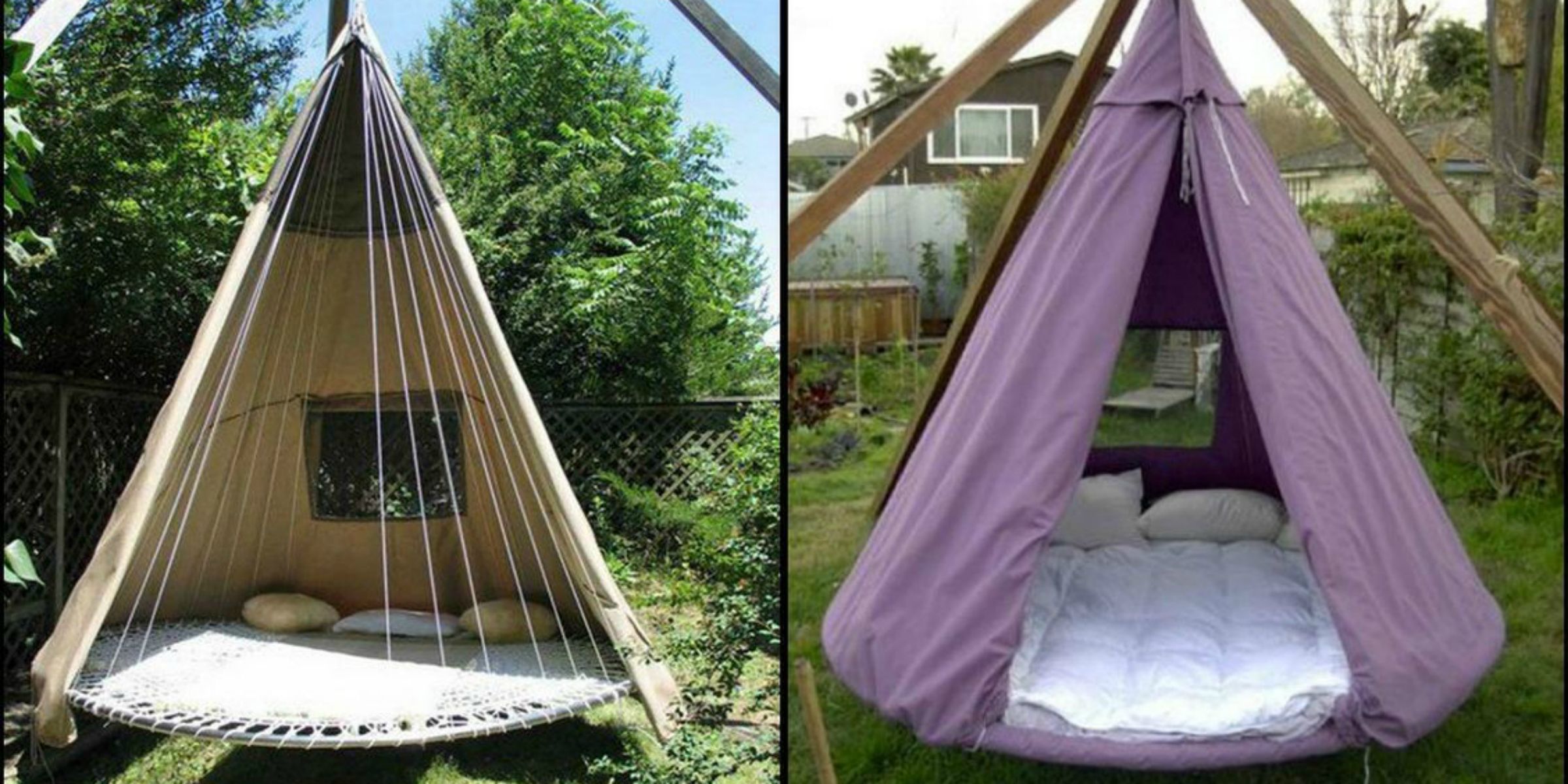- 8 Airplane Footrest Hammock!Travel comfortably - October 9, 2023
- top 7 Pool Float Water Hammock for a Relaxing Summer - October 9, 2023
- top 5 Space SaverSingle Hammock Stand Maximize Comfort and Space - October 9, 2023
To make a hammock out of a trampoline, wrap ropes with high-tensile strength around the metal frame and hang the swing from the trampoline legs. Create an opening so you can get into the swing, and ensure stability and safety by padding the frame and using strong ropes.
Other creative uses for old trampolines include turning them into hammocks, garden features, or floating seats. By repurposing the trampoline mat, you can create elevated gardens or tepee-like beds. With a few DIY steps, you can transform your old trampoline into a comfortable and relaxing hammock or swing.
Materials Needed
Trampoline
When it comes to making a hammock out of a trampoline, the first and most crucial material you’ll need is, of course, a trampoline. You can repurpose an old or unused trampoline and transform it into a comfy hammock that’s perfect for lounging and enjoying the outdoors.
Rope Or Straps
To hang your trampoline hammock securely, you’ll need rope or straps. These will be used to anchor and suspend the hammock between the trampoline’s frame or legs. Opt for high-tensile strength ropes or sturdy straps that can withstand your weight and provide durability.
Fabric Or Hammock Material
Next, you’ll need fabric or hammock material to create the actual hammock bed. Look for a fabric that is strong, comfortable, and designed for outdoor use. Nylon or polyester are popular choices due to their durability and resistance to weather conditions. Make sure the fabric is wide enough to accommodate your body comfortably.
Scissors
Scissors are essential for cutting the fabric or hammock material to the desired size and shape. Make sure to use sharp scissors that can cleanly cut through the fabric without fraying or damaging it.
Hanging Hardware (optional)
If you prefer a more permanent and stable setup, you may want to consider using hanging hardware to securely attach the hammock to the trampoline. This can include hooks, carabiners, or other hanging accessories that will provide additional support and stability to the hammock.
Step 1: Prepare The Trampoline
Once you have chosen the trampoline you want to transform into a hammock, it’s important to properly prepare it before starting the conversion process. This step ensures that the hammock will be safe and sturdy for use.
Remove The Safety Enclosure, Net, And Any Other Accessories From The Trampoline.
The first thing you need to do is clear the trampoline of any safety enclosures, nets, or other accessories that may be attached to it. These items are not needed for the hammock conversion and may interfere with the process. Remove them carefully, following the manufacturer’s instructions if available.
Clean The Trampoline Surface To Ensure It Is Free From Dirt And Debris.
To ensure the hammock provides a clean and comfortable resting area, it is important to clean the surface of the trampoline. Remove any dirt, leaves, or other debris that may have accumulated on the trampoline. Use a gentle cleaning solution or soapy water to wipe down the surface and rinse it off thoroughly. Allow the trampoline to dry completely before proceeding to the next step.
Check For Any Damages Or Rust On The Trampoline Frame And Repair If Necessary.
Inspect the trampoline frame for any damages or signs of rust. Check for any loose or broken parts, ensuring that the frame is structurally sound. If you notice any damages or rust, repair or replace the affected areas before continuing with the hammock conversion. This will help ensure the hammock is safe and durable for use.
By removing the safety enclosure, cleaning the trampoline surface, and checking for damages or rust on the frame, you have successfully prepared the trampoline for the hammock conversion process. This step sets a solid foundation for creating a comfortable and relaxing hammock out of your trampoline.
Step 2: Measure And Cut The Fabric
After you have disassembled the trampoline and removed the jumping mat, it’s time to measure and cut the fabric for your hammock. This step is crucial in ensuring that your hammock fits perfectly on the trampoline surface. Follow these steps:
Measure The Size Of The Trampoline Surface To Determine The Dimensions Of The Fabric Needed For The Hammock.
Using a tape measure, carefully measure the length and width of the trampoline surface. Take note of these measurements as they will determine the size of the fabric needed for your hammock. Be sure to measure from edge to edge to ensure accuracy.
For example, if your trampoline surface measures 10 feet in length and 8 feet in width, you will need fabric that is at least 10 feet long and 8 feet wide.
Cut The Fabric According To The Measurements, Leaving Extra For Sewing Or Attaching.
Once you have determined the dimensions of the fabric needed, use sharp scissors or a fabric cutter to cut the fabric accordingly. It’s always better to cut the fabric slightly larger than the actual measurements to allow for sewing or attaching.
In our example, you would need to cut a piece of fabric that is approximately 12 feet long and 10 feet wide to provide enough material for attaching or sewing.
Remember to take your time and make clean, straight cuts to ensure a neat and professional-looking hammock.
Now that you have measured and cut the fabric, you can move on to the next step of creating your trampoline hammock.

Credit: www.housebeautiful.com
Step 3: Attach The Fabric To The Trampoline
Once you have prepared the trampoline by removing the safety net and any unnecessary parts, it’s time to attach the fabric to create your hammock. Follow these steps to ensure a secure and comfortable hammock:
Secure The Fabric To The Trampoline Using Ropes Or Straps
To attach the fabric to the trampoline, you can use either ropes or straps. Make sure to choose high-quality, durable materials that can withstand the weight and pressure.
- Start by positioning the fabric evenly over the trampoline surface.
- Secure one end of the fabric to the trampoline frame using a strong rope or strap.
- Stretch the fabric tightly across the trampoline surface to eliminate any sagging or looseness.
- Secure the other end of the fabric to the opposite side of the trampoline frame using another rope or strap.
This method of attachment ensures that the fabric remains in place and provides a stable and comfortable surface for your hammock.
Make Sure The Fabric Is Evenly Spread Out And Taut Across The Surface
It’s important to ensure that the fabric is evenly spread out and taut across the surface of the trampoline. This will prevent any imbalance and provide a stable and comfortable hammock.
- Double-check that the fabric is evenly distributed, with no excess material in one area.
- Adjust the tension of the fabric by tightening or loosening the ropes or straps as needed.
- Ensure that the fabric is stretched tautly across the trampoline surface, avoiding any wrinkles or folds.
By ensuring that the fabric is evenly spread and taut, you’ll be able to relax comfortably on your hammock without any discomfort or instability.
Tie The Ropes Or Straps Securely To Prevent Slipping Or Sagging
Properly securing the ropes or straps is crucial to prevent any slipping or sagging of the fabric. Follow these steps to tie the ropes or straps securely:
- Loop one end of the rope or strap through a sturdy attachment point on the fabric.
- Tie a secure knot, ensuring that it is tight and will not come undone. You can use a double knot or any other reliable knotting technique.
- Repeat the process for the other end of the rope or strap, ensuring both sides are tied securely.
By tying the ropes or straps securely, you can enjoy your hammock without any worries of it slipping or sagging.
Following these steps, you can successfully attach the fabric to your trampoline and create a comfortable and relaxing hammock. Remember to use high-quality materials and ensure that the fabric is evenly spread out and taut across the surface. Secure the fabric using ropes or straps, tying them securely to prevent slipping or sagging. Now you can sit back, unwind, and enjoy the gentle sway of your trampoline hammock.
Step 4: Create Hanging Points (optional)
Step 4: Create Hanging Points (Optional)
If desired, you can install hanging hardware on the trampoline frame to create additional support for the hammock. This step is optional, but it can provide extra stability and ensure a comfortable and secure hammocking experience. Here’s what you need to know:
If Desired, Install Hanging Hardware On The Trampoline Frame To Create Additional Support For The Hammock.
If you want to add hanging hardware to your trampoline hammock, it’s important to choose strong and reliable hardware. This will ensure that the hammock can safely support your weight and provide a stable and enjoyable resting place. Here are some key points to consider:
- Choose heavy-duty hooks or carabiners that are designed to hold a significant amount of weight. Look for ones that are made from sturdy materials like stainless steel or aluminum.
- Make sure the hooks or carabiners are securely attached to the trampoline frame. You can use screws or bolts to fix them in place, ensuring that they won’t come loose during use.
- Position the hanging hardware in the corners or along the sides of the trampoline frame, depending on your preferred hammock setup.
Ensure That The Hanging Hardware Is Strong And Securely Attached.
When installing the hanging hardware, it’s crucial to ensure that each hook or carabiner is strong and securely attached. This will prevent any accidents or damage to the trampoline. Here’s what you need to do:
- Inspect each hook or carabiner to make sure it is in good condition and free from any defects or damage.
- Attach the hardware to the trampoline frame using screws or bolts. Make sure to tighten them securely, so they won’t come loose over time.
- Gently test the stability of the hanging hardware by applying some weight or pulling on it. If it feels secure and holds up well, you can proceed with attaching the hammock.
By following these steps and ensuring that the hanging hardware is strong and securely attached, you’ll be able to create an additional support system for your trampoline hammock. This will provide you with peace of mind and a comfortable place to relax and unwind.
Step 5: Test And Adjust
Test The Hammock By Gently Sitting Or Lying On It.
Once you have completed the previous steps of transforming your trampoline into a hammock, it’s time to test it out. Gently sit or lie on the hammock to get a feel for how it supports your weight. This step is crucial to ensure that the hammock is comfortable and safe to use. Take a moment to get comfortable and see how the fabric responds to your body’s weight.
Make Any Necessary Adjustments To Ensure The Hammock Is Comfortable And Properly Supported.
If you find that the hammock is not as comfortable as you’d like or if you notice any areas that are not properly supported, make the necessary adjustments. You can adjust the tension of the fabric by tightening or loosening the ropes or straps that secure it to the trampoline frame. Additionally, you can add padding or cushions to enhance comfort.
Check For Any Signs Of Stress Or Strain On The Trampoline Or Fabric And Reinforce If Needed.
It’s important to examine the trampoline and fabric for any signs of stress or strain. Look for any tears, fraying, or weak spots that might compromise the hammock’s integrity. If you notice any issues, reinforce them immediately to prevent further damage. This may involve patching or replacing the fabric or reinforcing the trampoline frame with additional supports.
By testing the hammock, making necessary adjustments, and checking for signs of stress or strain, you can ensure that your trampoline hammock is not only comfortable but also safe to use. Enjoy your newly transformed outdoor oasis and relax in your homemade hammock!
Frequently Asked Questions Of How To Make A Hammock Out Of A Trampoline
Can You Attach A Swing To A Trampoline?
Yes, you can attach a swing to a trampoline by wrapping ropes with high-tensile strength around the padded metal frame and hanging the swing from the legs of the trampoline. Make sure to leave an opening for getting in the swing.
Source: DIY Trampoline Bed Swing – How To Upcycle Your Trampoline.
What Can I Make With An Old Trampoline?
You can repurpose an old trampoline by turning it into a hammock or a swing bed. Remove the legs, cover the metal frame, and wrap strong ropes around it to create a comfortable and relaxing outdoor seating. You can also use the trampoline mat as a base for an elevated garden or a floating seat.
What Can I Do With An Old Trampoline Mat?
You can repurpose an old trampoline mat in several ways. You can use it as an elevated garden base or create a floating seat. Additionally, you can turn the trampoline into a swing bed by removing the legs and wrapping the frame with ropes for support.
How Do You Turn A Trampoline Into A Swing?
To turn a trampoline into a swing, take off the legs and cover the metal frame with a pool noodle or foam padding. Wrap high-tensile strength ropes around the frame to hang the swing. (Hint: leave an opening for getting in and out).
DIY Trampoline Bed Swing – How To Upcycle Your Trampoline.
How Can I Make A Hammock Out Of A Trampoline?
To make a hammock out of a trampoline, follow these simple steps:
How Do I Attach A Swing To A Trampoline?
To attach a swing to a trampoline, wrap ropes around the padded metal frame and loop them to hang the swing.
What Can I Do With An Old Trampoline?
There are many creative options for repurposing an old trampoline, such as turning it into a chicken coop or a hanging bed.
Conclusion
Transforming your old trampoline into a cozy hammock is a creative and fun DIY project. By repurposing the frame and using strong ropes, you can create a unique and relaxing spot in your backyard. This upcycling idea not only saves money but also minimizes waste.
So, why not give this project a try and enjoy your very own hammock made from a trampoline? Get ready to swing and relax in your new hammock paradise!






